Location
On a West facing wall behind the pulpit.

Portrait
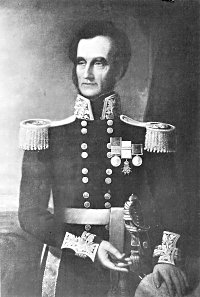
Replacement Headstone
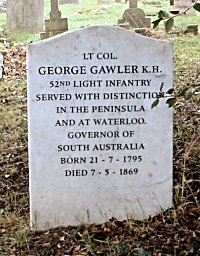
Cemetery Map
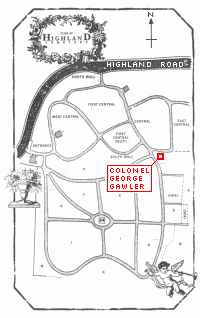
Original Headstone (2005)
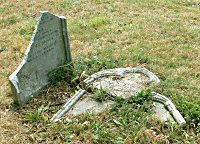
Original Headstone Reconstructed

Kent Lodge
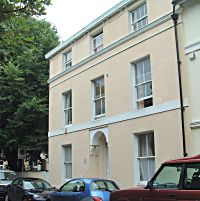
Central Southsea 1867
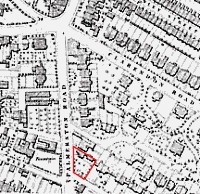
COLONEL GEORGE GAWLER KH
LATE 52ND LIGHT INFANTRY WHO DIED AT SOUTHSEA MAY 7TH 1869 HE WAS THE ONLY SON OF THE LATE CAPT SAMUEL GAWLER 73RD REGT COLONEL GAWLER WAS A FAITHFULL SOLDIER OF HIS GOD AND OF HIS COUNTRY. HE ENTERED THE 52ND REGT IN OCTOBER 1810 AND WAS PRESENT AT THE STORMING OF BADAJOZ, THE BATTLE OF VITTORIA, VERA. THE NIVELLE, THE NIVE, ORTHES, TOULOUSE AND WATERLOO. HE RETIRED ON HALF-PAY IN 1834 WAS APPOINTED GOVERNOR OF SOUTH AUSTRALIA IN 1838 AND RETURNED TO ENGLAND IN 1842. FOR UPWARDS OF
50 YEARS HE "FOLLOWED THE LORD FULLY" AND BY GOD'S GRACE MAINTAINED A STEADY CHRISTIAN WALK UNTIL AFTER A SHORT ILLNESS HE WAS CALLED TO ENTER INTO THE JOY OF HIS LORD, IN HIS DYING MOMENTS HE FERVENTLY SAID "NEVER A CLOUD ON MY ONENESS WITH JESUS IN THE FULNESS OF THE SPIRIT"
Further Information
GEORGE GAWLER was born on the 2Ist July 1795, and came of a fighting family; his father, Captain Samuel Gawler of the 73rd Highlanders, having been killed at the storming of Fort Maggerall (Southern India) in 1804, and his grandfather, John Gawler, having been present at the battle of Quebec in 1759.
He entered the Royal Military College (then at Great Marlow), as a Gentleman Cadet, in October 1808, was promoted Corporal and Under Officer, and received a free commission as Ensign in the 52nd Light Infantry on the 4th October 1810, being then only 15 years and 3 months old. In January 1812 he proceeded with the 2nd Battalion 52nd to Lisbon, and shortly after arrival was transferred to the 1st Battalion, with which he took part in the assault on Badajoz on the 6th April 1812. His personal experiences on this occasion are interesting:-
I planted the leading ladder, and went down it; the other ladders followed very quickly. The last ladder was not steady when the enemy's fire opened. The light was most brilliant. I saw distinctly all the ditch to the Bastion of Santa Maria on the left, and along a good part of the counterscarp of the proper left face of the ravelin. I scrambled immediately to the top of the ravelin to look for the way to the centre breach, having had no orders to attack any in particular ; and on the top of the parapet of the proper left face was struck by a musket ball on the bone of the right knee, and rolled over the left face of the ravelin into three or four feet of water. Just as I fell, the discharge of a field piece from the flank of Santa Maria passed close to me, pointed, very probably, at the head of tlie 4th Division stormers, who might at this moment have been making their first attempt to descend the counterscarp opposite La Trinidad.
Holding on to the bank, I got out of the water a yard or two from the salient angle of the unfinished ravelin, and was in the ditch until after the bugles had concluded sounding the retreat.
A full description of this engagement is given in the Historical Record of the 52nd, concluding with the following incident:-
Cool generosity did not forsake the British soldier to the last. One of them made a wounded officer of the 52nd (Ensign Gawler) take hold of his accoutrements that he might drag him up a ladder ; "or," said he, " the enemy will come out and bayonet you." The fine fellow was just stepping on the covered way, when a thrill was felt by the hand which grasped his belts, and the shot which stretched him lifeless threw his body backward into the ditch again, while the officer whom he had rescued crawled out upon the glacis.
Gawler was promoted Lieutenant 12th May 1812, and served with the Regiment until the end of the war in 1814. He was wounded by a musket shot in the neck at the skirmish at San Munoz, November 17th 1812, and was present at Vittoria, Vera, the Nivelle, the Nive, Orthes, Toulouse, and many minor engagements, receiving eventually the Peninsular Medal with seven clasps. He served also with the Regiment at the battle of Waterloo, of which, shortly afterwards, he wrote :-
As he was in command of the right Company of the 52nd (after Captain Diggle was wounded), he had full opportunities of observing, as well as of taking part in, the memorable manoeuvre that resulted in the defeat of "that portion of the Imperial Guard of France, about 10,000 in number, which advanced to make the last attack on the British position." The quotation is from Lord Seaton's - Regiment at the Battle of Waterloo, by the Rev. William Leeke, who carried the Regimental Colour at Waterloo, and who, it maybe interesting to remark, subsequently married George Gawler's sister-in-law.
After this Gawler did duty with his Regiment in France, England, and New Brunswick, marrying in 1820 Maria, daughter of John Cox, of Derby and Quarndon near Derby. In 1825 he purchased a Company in the Regiment, and in 1831 his majority, being promoted, on the 12th August 1834, to an unattached Lieut-Colonelcy. For four years he remained practically unemployed, though it is unnecessary to say that he found ample work to occupy his leisure time. [For some years he had been assisting Captain Siborne in his famous model of Waterloo, now at the National Army Museum, Chelsea. The full story of the model is told in "Wellington's Smallest Victory" by Peter Hofschroer who is of the opinion that "Gawler probably thought his contribution to Siborne's research (and the model) invaluable. Siborne probably could have done without it...........He bombarded poor Siborne with massive missives over a period of years and was obsessed with the role of his regiment."]
In 1833 Gawler had published his Close and Crisis of Waterloo - a pamphlet of very considerable note; he now returned to military literature, and, in 1837, published The Essentials of Good Skirmishing (reprinted in the Chronicle, 1897). This was a very remarkable book, the principles laid down in which are as sound after a lapse of sixty-four years as they were when written down; even forming the foundation of the resuscitated skirmishing in the new Infantry Drill. While on this subject we will quote from a letter written, on the fifty-third anniversary of Waterloo, by George Gawler to his son:-
This really wonderful, thoroughly fought-out, battle was won under God (by British sturdiness, no doubt), but under the drill system of Pliable Solidarity. Stiff Solidarity characterized the European armies up to the French Revolution of 1792. Then the wild sans-culottes, the French, were obliged to assemble, and adopted the system of Elan with as little of the solidarity as they could do with. Then good common-sense heads in England devised, first under Sir John Moore at Shorncliffe, Pliable Solidarity. With this system the old Duke out-manoeuvred every army opposed to him, and never lost a battle. To the very end of the day (Waterloo) we manoeuvred by well-formed battalions, as smoothly and as rapidly as we should have done on Southsea Common. While from the beginning of the day French Elan, like soda-water, had to be corked up in masses. The moment the density was rudely broken, all went off in smoke and confusion.
In 1838 Lieut-Colonel Gawler (who had in the previous year been decorated with the Third Class of the Royal Hanoverian Guelphic Order) was appointed Governor of South Australia, succeeding Captain (afterwards Sir John) Hindmarsh, the first Governor. His task was a difficult one, as he was practically the founder of the new colony; and what he did for the advancement of South Australia is now a matter of history. He worked hard and conscientiously during the three years that he remained at his post; but this was in the days when the British Government disapproved of any great expenditure on the Colonies, and fault was found with him for spending a sum of money which to-day would be voted for a similar purpose by any Government in ten minutes. Suffice it to say that he was recalled, and, thoroughly disgusted with the injustice with which he had been treated, he made no further attempt to obtain employment. He took the keenest interest, however, in public affairs and more especially in military matters, and he contributed numerous important articles to the press.
"On the 21st of May, 1850," says the Historical Record of the 52nd, " Brevet-Colonel George Gawler was gazetted from half-pay into the Regiment, in order to enable him, after a long and honourable service in the 52nd, to retire from the Army by the sale of his commission. Colonel Gawler was essentially a 52nd officer. He served in this Regiment only, and was a type of that steady, cool, and gallant set of company officers whose attention to regimental duty and experience in the field so materially helped to place the 52nd amid the most distinguished in the service of Britain."
After this, Colonel Gawler settled down at Southsea, where he died in 1869, and was buried, on the 13th May. Five children survived him, one of whom his eldest daughter married in 1847 George Hall, Governor of the Juvenile Reformatory Prison, Parkhurst, and formerly Lieutenant 52nd Light Infantry. To George Hall's widow and to his son, Mr. Hammond Hall, we are indebted for much valuable information, as well as for the portrait of the subject of this Memoir. Miss Jane Cox Gawler, of Quarndon, has also kindly placed at our disposal papers relating to her father, and notably a small book, entitled George Gawler, K.H., 52nd Light Infantry, A Life Sketch, printed in 1900, bearing the 52nd badge, and bound in buff, the old regimental facings.
[Extract from the Regimental Chronicles by kind courtesy of the Oxfordshire & Buckinghamshire Light Infantry Museum]
Colonel Gawler in Southsea
George Gawler moved to Southsea in the mid 1850s and found life outside the military world "irksome". He maintained his interest by establishing a Bible reading class for military and Naval officers, which by all accounts was very popular.
The 1861 Census, shows Gawler residing at Kent Lodge (see photo) which still exists and is on the corner of Kent Road and Queens Crescent. The entry in the Census includes the fact that Gawler was born in London, Middlesex, which contradicts earlier suggestions that his birthplace was at Chulmleigh Hall, Chudleigh, Devon. Living with him at Kent Lodge were his wife Maria, daughters Jane (26) and Katherine (24) and two servants. Kent Lodge is located in what was in 1861 one of the most fashionable areas of Southsea. It is not known if he owned the property or was simply renting it prior to moving to his final address a short time later.
The last years of George Gawler's life were lived at Southsea Villa, Palmerston Road, Southsea which was between Villiers Road and Auckland Road East. An Ordnance Survey map of 1867 shows the house to have been of substantial dimensions, sitting in it's own grounds, with what appear to be formal gardens between the house and Palmerston Road (see map - the house is outlined in red). The house was demolished soon after his death but some of the garden walls are thought to remain.
According to A Life Sketch - "On the occasion of a gigantic Volunteer Review at Southsea in April 1868, in which 36,000 men engaged, he (Gawler) wrote to Major-General Lindsay asking his permission to have the old 52nd colours sent down from the United Services Institution.......in order that he might decorate the exterior of his house with them. Permission was readily granted, and many a young officer turned to salute them as they passed"
Little else about his life in Southsea has been discovered. Nor do we know why his memorial is in St Simon's Church rather than St Judes which was a lot closer to both of the houses he is known to have inhabited.
The Grave and Headstone
George Gawler is buried in Highland Road Cemetery, Southsea (Section A, Row J). The exact location of the grave had not been identified in 2002 when the Royal Greenjackets Regiment decided to recognise Gawlers importance to the Regiment by erecting a new headstone (see photo). As the exact location was not known the stone was placed under a tree in the proximity of the grave. In July 2005, further investigation of the area uncovered the broken remains of the original headstone (see photo), one piece of which was still in place, thereby identifying the exact location of the grave. This is about 20 metres east of the replacement headstone, immediately adjacent to a path. As there was very little missing from the headstone it has been possible to re-create it digitally (see photo) and as most of the text remains we can easily transcribe it.
Original Inscription
Memory of
COLONEL GEORGE GAWLER K.H.
LATE 52ND LIGHT INFANTRY
WHO DIED AT SOUTHSEA
MAY 7TH 1869
AGED 73
"HE WALKED WITH GOD
A MEMBER OF HIS B---- OF HIS ----
AND OF HIS BONES" EPHES 5 80
MARIA
WIFE OF THE ABOVE
DIED AT DERBY MARCH 25TH 1870
AGED 74 YEARS
"WHOSOEVER LIVETH AND BELIEVETH
IN ME SHALL NEVER DIE"
References
See also:
52nd Oxfordshire Light Infantry Reenactment and Research Group
The Royal Green Jackets Museum
The Dictionary of Australian Biography
